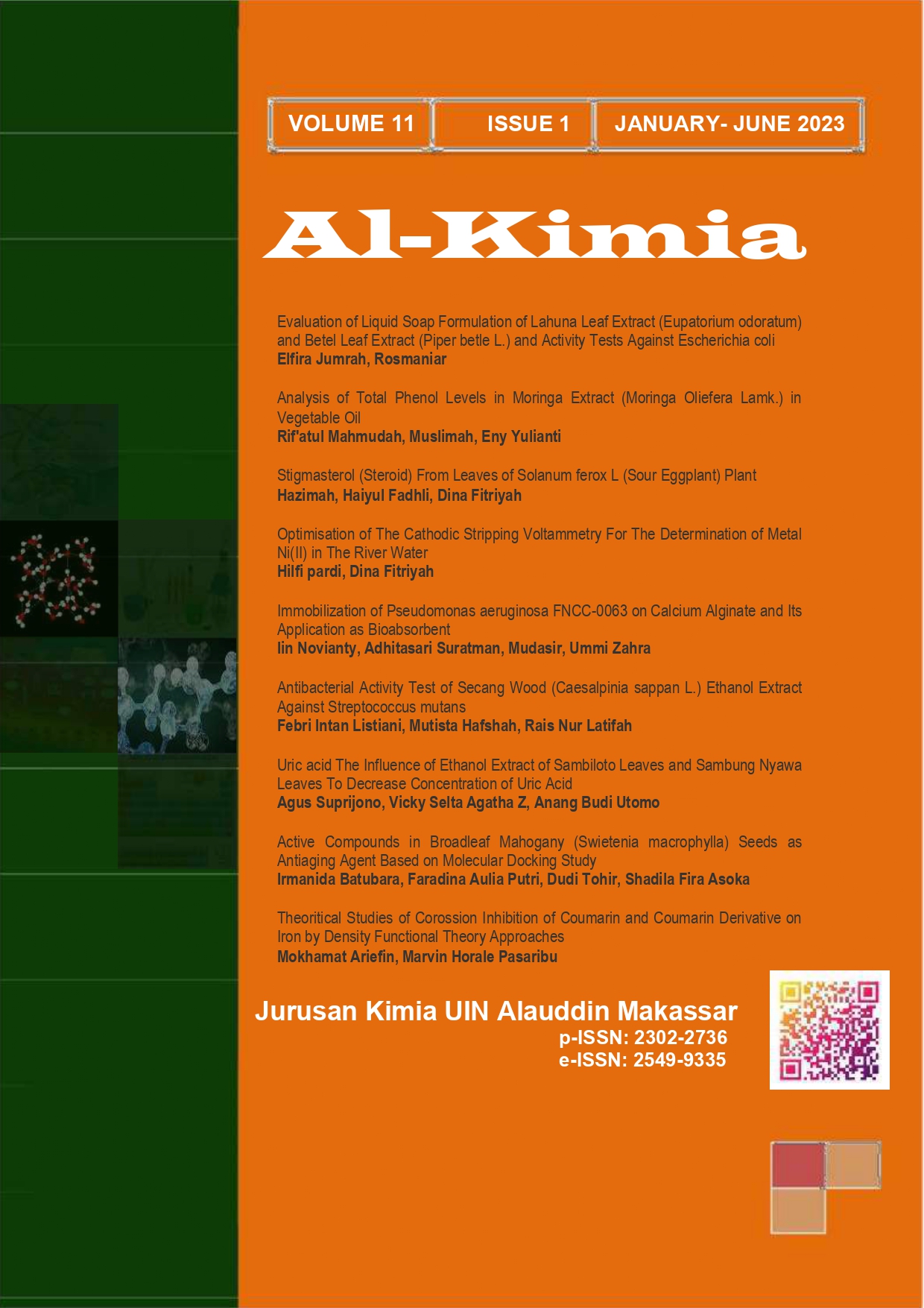The The Effectivity of Palm Oil Kernel Shell (OPS-Fe3O4) for Phenol Waste Degradation Routes
Abstract
Phenol is a type of hazardous waste that can irritate skin, eyes, and mucous membranes in humans. It has been discovered that the phenol content in wastewater generally ranges from 1-6800 ppm. Phenol removal applications such as adsorption separation are highly recommended, one of which is the application of activated carbon. Activated carbon can be produced from natural biomass which has a high content of lignin, carbon, and hemicellulose. One of the most developed biomass is OPS (Palm Oil Kernel Shell). OPS’ texture is a hard textured endocarp and dark gray. To increase waste degradation, the application of magnetite (Fe3O4) was found to be an effective modification of the adsorbent. In the experimental results, variations in adsorbent dosage, particle size, and contact time were carried out. At various adsorbent doses, the addition of 1g/ml was more effective in producing up to 98.5% removal. Meanwhile, the size of 0.05 mm produces highest degradation when compared to 0.22 mm and 0.55 mm. The optimum contact time reveals that it occurs in the range of 50-60 minutes. The FTIR results revealed that the most abundant O-H, C=C and N-H content was found to be adsorbed at each particle size.
Downloads
References
Ali, A., Siddique, M., Chen, W., Han, Z., Khan, R., Bilal, M., ... & Shahzadi, I. (2022). Promising low-cost adsorbent from waste green tea leaves for phenol removal in aqueous solution. International Journal of Environmental Research and Public Health, 19(11), 6396.
Alni, A., Puspita, K., & Zulfikar, M. A. (2019). Biosorbent from Chinese cabbage (Brassica pekinensia L.) for phenol contaminated waste water treatment. Key Engineering Materials, 811, 71-79.
Banat, F. A., Al-Bashir, B., Al-Asheh, S., & Hayajneh, O. (2000). Adsorption of phenol by bentonite. Environmental pollution, 107(3), 391-398.
Chang, G., Huang, Y., Xie, J., Yang, H., Liu, H., Yin, X., & Wu, C. (2016). The lignin pyrolysis composition and pyrolysis products of palm kernel shell, wheat straw, and pine sawdust. Energy Conversion and Management, 124, 587-597.
Dutta, N. N., Borthakur, S., & Patil, G. S. (1992). Phase transfer catalyzed extraction of phenolic substances from aqueous alkaline stream. Separation Science and Technology, 27(11), 1435-1448.
Li, M., Wang, Y., Liu, Y., Wang, H., & Song, H. (2022). Preparation of active carbon through one-step NaOH activation of coconut shell biomass for phenolic wastewater treatment. Research on Chemical Intermediates, 48(4), 1665-1684.
Hairuddin, M. N., Mubarak, N. M., Khalid, M., Abdullah, E. C., Walvekar, R., & Karri, R. R. (2019). Magnetic palm kernel biochar potential route for phenol removal from wastewater. Environmental Science and Pollution Research, 26, 35183-35197.
Hameed, B. H., & Rahman, A. A. (2008). Removal of phenol from aqueous solutions by adsorption onto activated carbon prepared from biomass material. Journal of hazardous materials, 160(2-3), 576-581.
Ho, S., & Khan, M. M. H. (2020). Short review on the use of oil palm shell in concrete and activated carbon. World Journal of Nano Science and Engineering, 10(01), 1.
Rodrigues, V. S., Andrade, L. M., & Tenório, J. A. S. (2021). Biodegradation of phenolic compounds in waste foundry sand: Physical and chemical characterization of foundry sand and bacterial degradation kinetics. Environmental Nanotechnology, Monitoring & Management, 16, 100575.
Saka, S., Munusamy, M. V., Shibata, M., Tono, Y., & Miyafuji, H. (2008). Chemical constituents of the different anatomical parts of the oil palm (Elaeis guineensis) for their sustainable utilization.
Shakir, A. A., Wan Ibrahim, M. H., Othman, N. H., & Shahidan, S. (2019). The effect of palm oil clinker and oil palm shell on the compressive strength of concrete. Iranian Journal of Science and Technology, Transactions of Civil Engineering, 43, 1-14.
Authors who publish with this journal agree to the following terms:
1) Authors retain copyright and grant the journal right of first publication with the work simultaneously licensed under a Creative Commons Attribution License that allows others to share the work with an acknowledgement of the work's authorship and initial publication in this journal.
2) Authors are able to enter into separate, additional contractual arrangements for the non-exclusive distribution of the journal's published version of the work (e.g., post it to an institutional repository or publish it in a book), with an acknowledgement of its initial publication in this journal.
3)Authors are permitted and encouraged to post their work online (e.g., in institutional repositories or on their website) prior to and during the submission process, as it can lead to productive exchanges, as well as earlier and greater citation of published work (See The Effect of Open Access).


